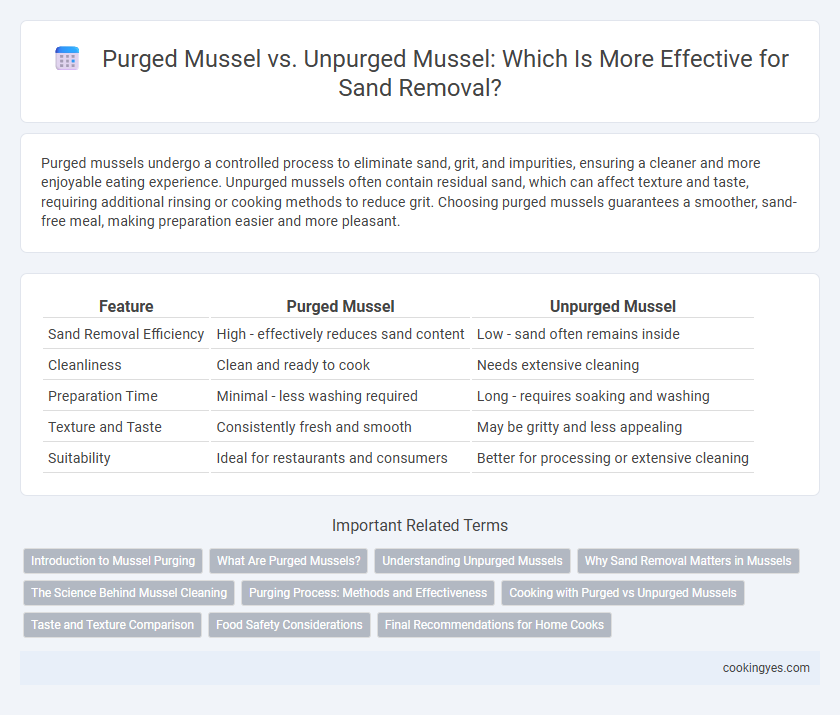Purged mussels undergo a controlled process to eliminate sand, grit, and impurities, ensuring a cleaner and more enjoyable eating experience. Unpurged mussels often contain residual sand, which can affect texture and taste, requiring additional rinsing or cooking methods to reduce grit. Choosing purged mussels guarantees a smoother, sand-free meal, making preparation easier and more pleasant.
Table of Comparison
| Feature | Purged Mussel | Unpurged Mussel |
|---|---|---|
| Sand Removal Efficiency | High - effectively reduces sand content | Low - sand often remains inside |
| Cleanliness | Clean and ready to cook | Needs extensive cleaning |
| Preparation Time | Minimal - less washing required | Long - requires soaking and washing |
| Texture and Taste | Consistently fresh and smooth | May be gritty and less appealing |
| Suitability | Ideal for restaurants and consumers | Better for processing or extensive cleaning |
Introduction to Mussel Purging
Mussel purging is a critical process to eliminate sand and grit trapped inside the shellfish, enhancing the quality and safety of the product. Purged mussels are typically soaked in clean seawater or saltwater tanks for 24 to 48 hours, allowing them to expel sand, grit, and other impurities naturally. Unpurged mussels often contain residual sand, which affects texture and consumer experience, making purging essential for commercial seafood preparation and consumption.
What Are Purged Mussels?
Purged mussels are mussels that have undergone a controlled depuration process to expel sand, grit, and impurities from their shells and digestive systems, ensuring a cleaner and more enjoyable eating experience. This process involves holding live mussels in clean seawater tanks that simulate their natural environment, allowing them to filter out unwanted particles. Compared to unpurged mussels, purged mussels significantly reduce the risk of consuming sand and improve texture and flavor quality.
Understanding Unpurged Mussels
Unpurged mussels often contain sand and grit trapped inside their shells, which can affect the texture and quality of dishes if not properly cleaned before cooking. Unlike purged mussels that have been soaked and filtered to expel impurities, unpurged mussels require thorough rinsing and manual de-bearding to minimize sand content. Understanding the differences in preparation techniques is crucial for achieving a clean, sandy-free mussel presentation and enhancing culinary outcomes.
Why Sand Removal Matters in Mussels
Effective sand removal in mussels is crucial to enhance their texture and consumer experience by preventing gritty mouthfeel. Purged mussels undergo a cleansing process that expels sand and grit accumulated during their habitat filter feeding, significantly improving product quality. Unpurged mussels retain sand particles that can cause discomfort and negatively impact culinary applications, making purging an essential step for superior mussel preparation.
The Science Behind Mussel Cleaning
Purged mussels undergo a controlled fasting period in clean seawater that triggers the bivalves to expel sand and grit naturally from their digestive systems. This depuration process reduces sand content significantly compared to unpurged mussels, enhancing texture and safety for consumption. Scientific studies confirm that maintaining optimal water quality and depuration duration is critical for effective sand removal in purged mussels.
Purging Process: Methods and Effectiveness
The purging process for mussels involves soaking them in saltwater or freshwater to induce the release of sand and grit trapped inside their shells, significantly improving their cleanliness. Methods such as cold freshwater soaking for 12-24 hours or saltwater rinsing with aeration enhance the effectiveness by stimulating the mussels to expel internal debris. Purged mussels demonstrate a marked reduction in sand content compared to unpurged mussels, resulting in better texture and taste during cooking.
Cooking with Purged vs Unpurged Mussels
Cooking with purged mussels ensures the removal of sand and grit, resulting in a cleaner, more enjoyable texture and taste. Unpurged mussels often retain sand, which can create an unpleasant, gritty mouthfeel and affect the overall flavor of the dish. Proper purging involves soaking mussels in salted water for at least 20 minutes, allowing them to expel sand, making purged mussels significantly preferable for culinary use.
Taste and Texture Comparison
Purged mussels undergo a cleansing process to expel sand, resulting in a cleaner texture and a more refined briny taste compared to unpurged mussels, which may retain gritty particles that affect mouthfeel and flavor purity. The purging process enhances the mussels' natural sweetness and tenderness, offering a smoother bite without the unpleasant crunch of sand. Unpurged mussels often present a tougher texture and a less consistent taste due to residual impurities, diminishing the overall eating experience.
Food Safety Considerations
Purged mussels undergo a depuration process that significantly reduces sand and grit, enhancing food safety by minimizing ingestion hazards. Unpurged mussels may retain sand and contaminants, increasing the risk of digestive discomfort and potential microbial presence. Proper purging ensures cleaner mussels, making them safer and more suitable for consumption.
Final Recommendations for Home Cooks
Purged mussels have been soaked and rinsed to expel sand and grit, making them ideal for home cooks seeking a hassle-free seafood preparation. Unpurged mussels require thorough rinsing and occasional soaking to ensure all sand is removed, which can increase prep time and risk of grit in the final dish. For a clean, pleasant eating experience with minimal effort, home cooks are recommended to purchase purged mussels or perform an effective purging process before cooking.
Purged Mussel vs Unpurged Mussel for sand removal Infographic

 cookingyes.com
cookingyes.com